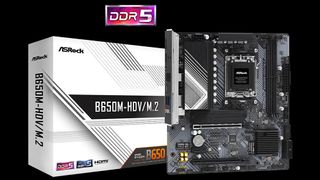When AMD launched its first Ryzen 7000 processors, in the flurry of technical announcements and publicity enthusiasts were told they would be able to grab a new AM5 motherboard "starting at $125." Finally, several months down the line, ASRock has at last fulfilled that promise with the ASRock B650M-HDV/M.2, reckons AMD’s CVP and GM of Ryzen channel business, David McAfee. Of course, it is right to wonder what ASRock may have done — what it may have sacrificed — to hit this important price point.

AMD’s Ryzen 7000 desktop processors haven’t quite been the sales success they could have been, and this is largely down to the thorny old issue of pricing. After admirably sticking with the AM4 platform for years, across multiple CPU generations, it finally came the time to change the bath water.
The design of the powerful Zen 4 processors made necessary some premium choices on the motherboard side of the equation. AM5 motherboards required relatively costly options such as a revamped power delivery system, they arrived with a new socket mechanism and retainer, and the platform didn’t allow for users to keep their old DDR4 RAM. At the higher end, there were even more extra costs to bear, with some models requiring multiple chipsets to deliver their full portfolio of expected features.
Turning our focus back to the ASRock B650M-HDV/M.2, it's no surprise that this is a pretty basic AM5 offering. It's a Micro-ATX formfactor, with just two DIMM slots and two M.2 slots capable of housing a 2280 storage device (one PCIe Gen 5x4, another PCIe Gen 4x4). Its VRM power design is basic too, with only some small, budget-style heatsinks visible.
Some users may also feel the pinch of just seven USB ports (four of which are USB 2.0). In a similar vein, there are just four SATA drive connectors. Onboard sound is the pretty old Realtek ALC897 chip, and of course there is no RGB here.

On the plus side, it's pleasing to see this motherboard offers 2.5 Gigabit LAN. Another positive is that the graphics card slot is reinforced for strength. It's also great that the easy and convenient BIOS flashback feature is present. ASRock’s B650M-HDV/M.2 has both HDMI and DP ports ready for the iGPU output, and there's a pre-installed I/O shield — one less thing to deal with when assembling modern PCs.
Interestingly, there are antenna mounting points if you decide to fit a Wi-Fi card, and an M.2 WiFi slot on the motherboard exists for precisely this purpose. So potentially you could grab something like this WiFi 6E adapter (opens in new tab) for $36 and use it with the ASRock board. Of course, in effect you'd then be spending $161 on your AM5 motherboard, which sort of defeats the purpose of having a cheap starting price in the first place. Still, the flexibility is nice to have.

Hopefully other motherboard makers will follow in ASRock’s footsteps soon, and it will be interesting to see how they compete. Those who are looking for a complete new platform and aren’t sure whether they are choosing AMD or Intel will want to look at the competitive features of Intel LGA1700 motherboards (for Alder Lake / Raptor Lake) too. Take a look at our Best Motherboards 2023 for Gaming, by Socket and Chipset for more details about the pros and cons of the various options.

